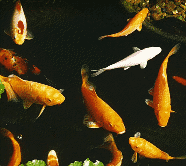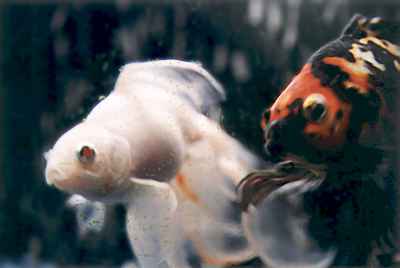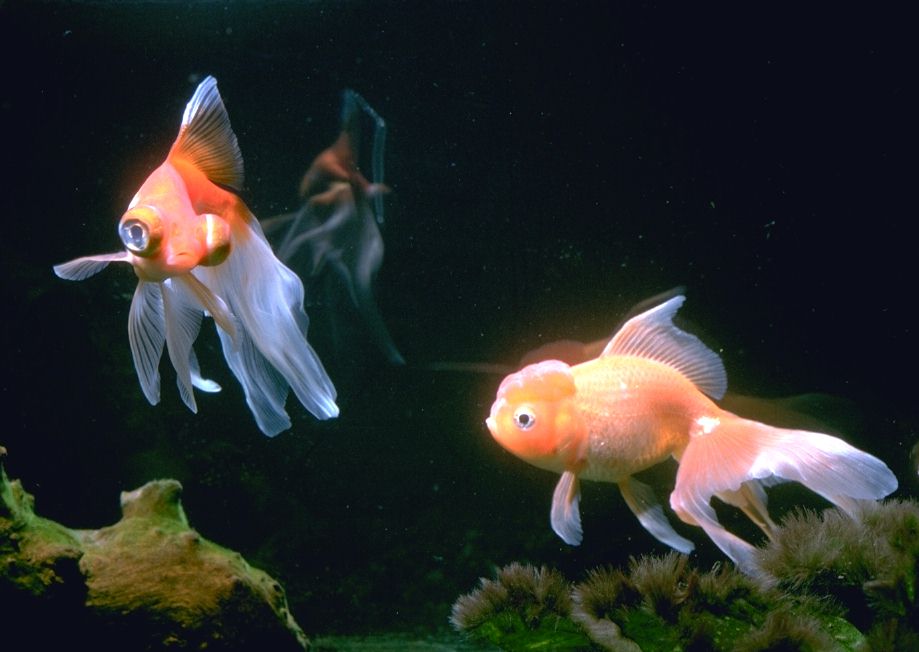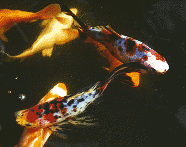Subjects:
by category
Ailments
* diagnosis
* diseases
* quarantine
* water
Care
* Basic
* Advanced
* Fishbowls
* water
change
Facilities
* bi-laws
* chapters
* mail
us
GoldfishSanc
The Goldfish Sanctuary
Varieties
There are, in fact, dozens of varieties of goldfish. These range from the Common Goldfish to multicolored varieties. Some of these varieties are not even available in the United States. The fish listed below are some of the most widely known varieties. Sizes are listed, but it should be noted that these are averages only ... any variety can grow beyond these lengths if given good care. Although different varieties can be mixed in the same tank, it is suggested that slow varieties be kept separately from the fast varieties to avoid conflict during feeding time.

Figure 1 |
Common GoldfishThis is the hardiest variety. The Common Goldfish is most often a bright orange color, but can also be yellow, silver, brown, or a mix of these. It has a stout body and a rounded caudal fin. This fish can grow to 8 inches long or longer if given good care and enough room. Water temperature should be from 33 - 68 degrees F. The Common Goldfish is an excellent choice for a pond. (The orange fish in Figure 1 are Common Goldfish.) |
Comet GoldfishSimilar to the Common Goldfish, the Comet often displays the same coloration.
Comets are longer and thinner than the Common Goldfish, and its caudal
fin is much longer. Its shape allows it great speed which it can sustain
for brief periods. The Comet may also grow to be quite long, given the
space, but will not reach the same size of the Common Goldfish. Water temperature
should be from 46 - 68 degrees F. An excellent pond fish. |

Figure 2 |

Figure 3 |
Fantail GoldfishThe Fantail variety has a rounded egg-shaped body and a twintail. It is a slow swimmer. This fish is among the smaller goldfish, a full-size fish being close to 4 inches long. This fish should be kept at 46 - 68 degrees F and should live in very clean water. The two fish pictured in Figure 3 are Calico Fantails. |
OrandaThe Oranda is most often orange or red and may have some white as well. When it reaches adulthood, the Oranda grows a red 'hood' over its head. A full-sized fish is about 5 inches long. These fish are best kept between 46 and 68 degrees F, and in very clean water. It is a slow swimmer. The Oranda in Figure 4 can be identified by its orange "hood." The relative age of an Oranda can be estimated based on the size of the head growth. |

Figure 4 |
Lionhead Goldfish
This fish is stout and has a typically gold or yellow color. The Lionhead can be identified by the fact that it has no dorsal fin. This fish can reach 5 inches at full size, requires very clean water, and temperatures ranging from 46 - 71 degrees F.
Celestial Goldfish
This fish is identified by its gold color, lack of a dorsal fin, and small, upturned eyes. A Celestial should only ever be kept with other Celestials. These fish reach up to 5 inches when they reach adult size. They should be kept in very clean water, and at temperatures from 46 - 71 degrees F.
Veiltail
The Veiltail is most often orange, although it may also be white or silver. This fish may grow to about 4 inches in length. The Veiltail's most striking feature, as its name implies, is the beautiful, flowing tail. The Veiltail also has a somewhat slimmer body than the Fantail or Common Goldfish. This fish requires very clean water from 46 - 68 degrees.
|
Figure 8 |
Bristol ShubunkinThis variety can have varied coloration from blue to orange, black, purple, yellow, brown, red, or some combination of these. As adults, these fish reach about 5 inches in length. They should be kept at 32 - 68 degrees F. A good pond fish.London ShubunkinThis typically blue fish can grow to 8 inches or larger. The London Shubunkin has a body shape similar to the Common Goldfish. It should be kept in water from 32 - 68 degrees F. |
Moor
Also called the Black Moor or Telescope Moor, this goldfish is mostly black, although it may also have some gold coloration. The Moor's eyes stick out on the sides - a very interesting characteristic. The Moor should be kept in very clean water from 46 - 68 degrees F.
The photos in figure 2 and figure 4 (goldie.jpg & comet.jpg) are by Erik Olsen of GSAS, and are used with permission. Image Shubunk and figure 1 are both taken from Pete's Pond Page and is used with the permission of the photographer, Pete Orelup. The picture of Teenage Mutant Ninja Goldfish (figure 3) is also used with permission.
